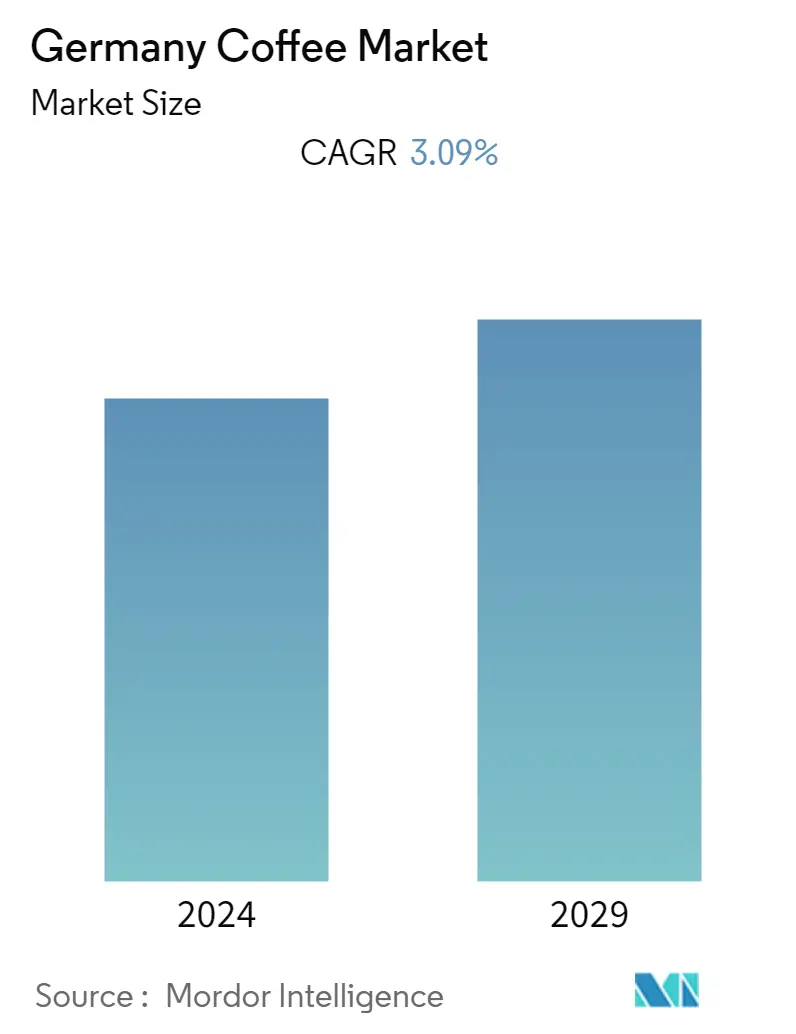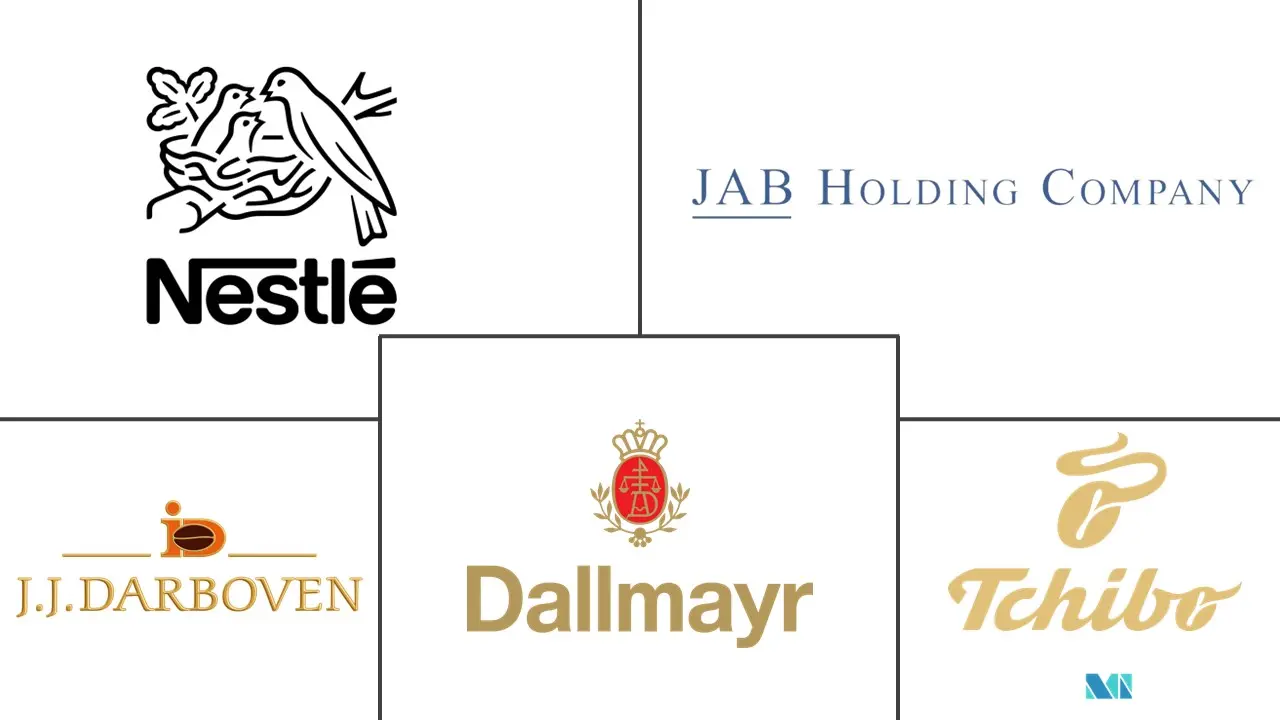Market Size of Germany Coffee Industry

| Study Period | 2019 - 2029 |
| Base Year For Estimation | 2023 |
| Forecast Data Period | 2024 - 2029 |
| Historical Data Period | 2019 - 2022 |
| CAGR | 3.09 % |
| Market Concentration | Low |
Major Players
*Disclaimer: Major Players sorted in no particular order |
German Coffee Market Analysis
The German coffee market is projected to register a CAGR of 3.09% over the forecast period.
In Europe, Germany is the largest country in terms of the consumption of coffee. The strong demand for freshly brewed coffee is driving sales in the market studied. Consumers' demand for specialty coffee is rising owing to increasing awareness and knowledge about the product. Another factor contributing to this trend is the rise in the number of coffee bars, small resident brands, small roasters, and baristas. Moreover, consumers have initiated a new trend of roasting coffee at home. This increased the sales of green beans instead of roasted beans.
According to a report from the German Coffee Association (GCA) in 2021, the per capita amount of coffee consumed on the German market has risen from 168 liters to 169 liters. This positive growth in the market in 2021, according to the GCA, is primarily due to increased sales of roasted coffee in the food retail sector. Roasted coffee consumption is increasing in restaurants, workplaces, and other out-of-home sites such as bakeries, cafés, restaurants, hotels, coffee shops, and bars, which is driving market growth. In addition, food retailers are witnessing a demand for sustainably sourced products in the country. In this scenario of increasing demand, certification schemes play vital roles as they build consumers' trust in products by providing transparency and traceability.
German Coffee Industry Segmentation
Coffee is a brewed drink prepared from roasted coffee beans, which are the seeds of berries from certain flowering plants in the Coffea genus. From the coffee fruit, seeds are separated to produce a stable, raw product: unroasted green coffee. The market is segmented by product types and distribution channels. Based on product type, the report segments the market into whole bean, ground coffee, instant coffee, and pods and capsules. Furthermore, by distribution channel, the market has been segmented into off trade and on trade. The off-trade distribution channel is further segmented into convenience stores, supermarkets/hypermarkets, and specialty markets. For each segment, the market sizing and forecasts have been done based on value (USD million).
| By Product Type | |
| Whole Bean | |
| Ground Coffee | |
| Instant Coffee | |
| Pods and Capsules |
| By Distribution Channel | |||||
| |||||
| On Trade |
Germany Coffee Market Size Summary
The German coffee market is experiencing a robust growth trajectory, driven by a strong demand for freshly brewed and specialty coffee. As the largest coffee-consuming country in Europe, Germany is witnessing a surge in consumer interest towards specialty coffee, fueled by increased awareness and the proliferation of coffee bars, small roasters, and baristas. This trend is further amplified by the growing popularity of home coffee roasting, which has led to a rise in the sales of green beans. The market is also seeing a significant increase in roasted coffee consumption across various out-of-home settings such as restaurants, cafés, and workplaces, contributing to its expansion. The demand for sustainably sourced coffee products is on the rise, with certification schemes playing a crucial role in ensuring transparency and building consumer trust.
Germany's coffee market is characterized by a competitive landscape, with major players like Nestle SA, JAB Holding Company, and Tchibo GmbH Coffee Company holding significant market shares. These companies are actively engaging in product innovation, facility expansion, and strategic mergers and acquisitions to enhance their product offerings and meet the increasing consumer demand. The market is also witnessing a shift towards organic coffee, with German consumers showing a preference for high-quality, light organic coffee, particularly from Brazil. This shift has led to organic coffee becoming a mainstream segment, driven by consumer demand for health-conscious and sustainable products. The ongoing import and consumption of organic coffee in Germany are expected to rise, reflecting the country's position as a key player in the European coffee market.
Germany Coffee Market Size - Table of Contents
-
1. MARKET DYNAMICS
-
1.1 Market Drivers
-
1.2 Market Restraints
-
1.3 Industry Attractiveness - Porter's Five Forces Analysis
-
1.3.1 Threat of New Entrants
-
1.3.2 Bargaining Power of Buyers/Consumers
-
1.3.3 Bargaining Power of Suppliers
-
1.3.4 Threat of Substitute Products
-
1.3.5 Intensity of Competitive Rivalry
-
-
-
2. MARKET SEGMENTATION
-
2.1 By Product Type
-
2.1.1 Whole Bean
-
2.1.2 Ground Coffee
-
2.1.3 Instant Coffee
-
2.1.4 Pods and Capsules
-
-
2.2 By Distribution Channel
-
2.2.1 Off Trade
-
2.2.1.1 Convenience Stores
-
2.2.1.2 Supermarkets/Hypermarkets
-
2.2.1.3 Specialist Retailers
-
-
2.2.2 On Trade
-
-
Germany Coffee Market Size FAQs
What is the current Germany Coffee Market size?
The Germany Coffee Market is projected to register a CAGR of 3.09% during the forecast period (2024-2029)
Who are the key players in Germany Coffee Market?
JAB Holding Company, Nestle SA, J J Darboven GmbH & Co. KG, Alois Dallmayr KG and Tchibo are the major companies operating in the Germany Coffee Market.

